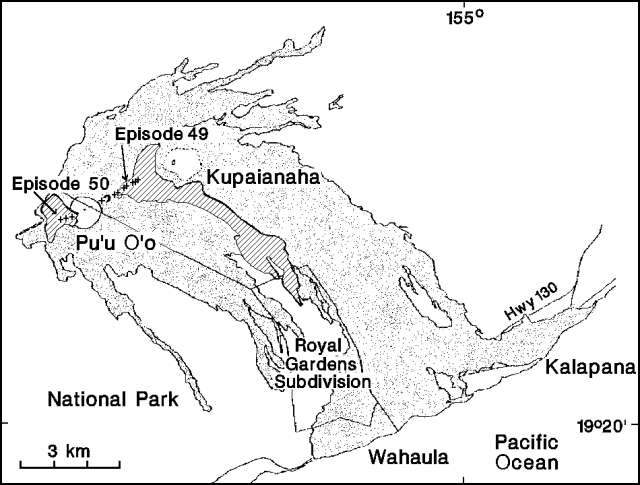Report on Kilauea (United States) — January 1992
Bulletin of the Global Volcanism Network, vol. 17, no. 1 (January 1992)
Managing Editor: Lindsay McClelland.
Kilauea (United States) Lava from new fissure; continued lava pond activity; lava production ends from shield vent
Please cite this report as:
Global Volcanism Program, 1992. Report on Kilauea (United States) (McClelland, L., ed.). Bulletin of the Global Volcanism Network, 17:1. Smithsonian Institution. https://doi.org/10.5479/si.GVP.BGVN199201-332010
Kilauea
United States
19.421°N, 155.287°W; summit elev. 1222 m
All times are local (unless otherwise noted)
The rate of lava production. . . decreased through January. Frequent lava breakouts occurred from the tube system at ~570 m (1,860 ft) altitude. The flows were initially fluid, covering portions of E-49 aa in early January, but as the eruption rate declined they became progressively more viscous and limited in areal extent. Fieldwork on 11 February indicated that lava production from Kupaianaha had stopped.
Lava emerged from vents in the bottom of Pu`u `O`o crater, 3 km uprift from Kupaianaha, through early February. Frequent overflows resurfaced the crater floor. The lava pond fed by the downrift vent since December showed continuous spattering and gas-pistoning through January. Early in the month, two vents on the crater's uprift side overflowed intermittently, supplying lava to the downrift pond. By 6 January, a lava pond had formed on the uprift side, with vigorous overflow and drainback episodes. Overflows fed the downrift pond, while drainback frequently emptied the uprift pond, exposing a vent 20 m wide in its floor. Refilling of the uprift pond was occasionally accompanied by dome fountains. A drainback episode on 10 January led to the collapse of a spatter rampart into the uprift pond's vent. The pond did not immediately refill and a small glowing hole was noted there on 17 January. Two days later, the uprift vent was again active, feeding lava into the downrift pond, where activity was vigorous. Tephra and spatter from this pond rose above the rim of Pu`u `O`o. The pond level fluctuated between 5 and 9 m below the crater floor during the last 10 days of the month. Overflows from one or both ponds resurfaced the crater floor between 25 and 31 January. By the end of January, the uprift pond had again stagnated, leaving a glowing hole in the crater floor.
A swarm of intermediate-depth long-period seismic events began on 20 January at about 0600. Earthquake counts peaked 21-22 January, when > 700 events were recorded, returning to low levels by 24 January. Shortly after midnight on 24 January, shallow seismicity increased in the SE part of the caldera and uppermost East rift zone, remaining high for the next several days.
Episode 50 (E-50). Lava production began on 17 February at about 1930 from a new fissure at Pu`u `O`o (figure 85). The fissure started about one-quarter of the way up the cone's W flank and extended ~100 m uprift. Low-level (3-5 m high) lava fountains fed small flows that moved N and ponded near the base of Pu`u `O`o. Discrete earthquakes did not appear to increase before the episode, but a 2-hour burst of increased tremor at the Pu`u `O`o seismic station began 1/2 hour before the fissure opened, and summit tiltmeters measured 1.5 µrad of deflation.
Geological Summary. Kilauea overlaps the E flank of the massive Mauna Loa shield volcano in the island of Hawaii. Eruptions are prominent in Polynesian legends; written documentation since 1820 records frequent summit and flank lava flow eruptions interspersed with periods of long-term lava lake activity at Halemaumau crater in the summit caldera until 1924. The 3 x 5 km caldera was formed in several stages about 1,500 years ago and during the 18th century; eruptions have also originated from the lengthy East and Southwest rift zones, which extend to the ocean in both directions. About 90% of the surface of the basaltic shield volcano is formed of lava flows less than about 1,100 years old; 70% of the surface is younger than 600 years. The long-term eruption from the East rift zone between 1983 and 2018 produced lava flows covering more than 100 km2, destroyed hundreds of houses, and added new coastline.
Information Contacts: T. Mattox and R. Okamura, HVO.


